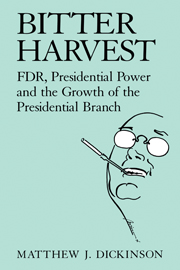Book contents
- Frontmatter
- Contents
- Preface and acknowledgments
- Introduction: The fruits of his labor? FDR and the growth of the presidential branch
- Part I Concepts and controversies
- Part II From cabinet to presidential government, 1933–9
- Part III Testing Roosevelt's staff system: The war years, 1939–45
- 4 Economic mobilization and World War II
- 5 Managing war production
- 6 FDR and the national security bureaucracy
- 7 The commander in chief
- Part IV Lessons and considerations
- References
- Indexes
4 - Economic mobilization and World War II
Published online by Cambridge University Press: 21 January 2010
- Frontmatter
- Contents
- Preface and acknowledgments
- Introduction: The fruits of his labor? FDR and the growth of the presidential branch
- Part I Concepts and controversies
- Part II From cabinet to presidential government, 1933–9
- Part III Testing Roosevelt's staff system: The war years, 1939–45
- 4 Economic mobilization and World War II
- 5 Managing war production
- 6 FDR and the national security bureaucracy
- 7 The commander in chief
- Part IV Lessons and considerations
- References
- Indexes
Summary
To test whether Roosevelt's institutional response is relevant today, its effectiveness must be evaluated under circumstances in which bargaining costs rival those faced by his successors. Economic mobilization during World War II is one such case. The need to mobilize the nation's economy for war confronted FDR with bargaining demands of unprecedented magnitude and complexity.
Roosevelt's objective on the home front was simple: to convert the nation's economy to munitions production as quickly as political constraints would allow. The execution, however, was politically and administratively complex. It encompassed two phases. The first, lasting roughly from 1938–41, laid the foundation for defense production within the constraints imposed by isolationists who actively campaigned against any American military involvement overseas. Phase two, covered in Chapter 5, began with the Japanese attack at Pearl Harbor in December 1941 and extended through the end of his presidency in 1945. In this period, FDR successfully sought to prosecute the war by integrating military strategy with war production while protecting his sources of bargaining support.
To accomplish these ends, FDR took three administrative steps: progressively imposing production and price controls to maximize munitions output while limiting civilian economic disruption; establishing institutional means to implement those controls; and, most important, devising coordinating agencies to ensure that these institutions worked in FDR's bargaining interest.
The various war mobilization and production agencies, most of which reported directly to FDR outside existing executive branch jurisdictions, eventually oversaw almost every sector of the nation's economy, including manufacturing, agriculture, manpower, wages and prices, import/ export trade, shipping, science research, and information and propaganda.
- Type
- Chapter
- Information
- Bitter HarvestFDR, Presidential Power and the Growth of the Presidential Branch, pp. 117 - 140Publisher: Cambridge University PressPrint publication year: 1996



